Hello again, everyone! In spite of the heavy snow and ice, our Indianapolis Open still
managed to amaze even me. Over five hundred players showed up to battle in the first Standard event to feature Mirrodin Besieged. Going into the
tournament, I expected most of the decks to be updates of existing Standard contenders; that’s just the nature of a tournament following the
introduction of a new set. Cards like Tezzeret, Agent of Bolas are tough nuts to crack, so I figured we’d see a lot of Green Sun’s Zenith, Sword of
Feast and Famine, and Go for the Throat—cards that could easily supplement or substitute existing choices in various archetypes.
Before I dive into the “maths” of the article, I wanted to take a moment to note what I consider the purpose of tournament statistics in Magic to be,
especially metagame measurements like the ones that this article and others include. This is merely my perspective, and it is based on the realistic
applications of the currently accessible data. I’m learning and exploring more ways to wring tournament results for meaningful information, and
suggestions are welcome, but the limiting factors of time and utility will always exist.
Each of these articles is a snapshot of an event, not a predictive model. While these results may indicate general conclusions, there is literally no
information contained in any of them that I would call a “sure thing.” The powerful amount of inherent variance in Magic unites with the small sample
size of a given tournament to create a very unpredictable system. In addition, the inclusion of the skill element makes a result equally impossible to
measure with significant accuracy or precision. As talented as any player may be, they can play one game horribly after playing the previous one
perfectly. They could even win the former and lose the latter—that’s Magic. It’s impossible to monitor this effect, as even limiting your data to
players above certain point thresholds doesn’t guarantee optimal play or decklists. It only assures us that one and/or the other was good enough most
of the time when measured against variance and their opponents’ mistakes.
A matchup analysis using tournament results can feature an 80% result one week and a 20% result the next—this is the fallibility of the system. Such
results become more unlikely as you increase sample sizes, but they remain possible. We’ll rarely, if ever, see one hundred matches between any two
archetypes, much less against the entire field. Grouping tournaments together to achieve such a measurement becomes distorted by players adapting their
lists in the wake of the previous tournament, which means that only Opens occurring close together and featuring no set releases or major metagame
shifts should ever be combined. Even then, there are risks.
I could examine only the records of Top 8 players, as other writers have done, or those with 6+ wins, but that tiny pool would only guarantee that we
saw the luckiest and best players in the tournament on a sliding scale with little ability to differentiate between them. Players will be luckier than
you, and they may often wield a skill edge that you don’t possess. I prefer to hope it evens out—I would rather see how Valakut did in the hands of all
94 players than in the hands of our Top 8 competitors if I wanted a general idea of how it performed in Indianapolis, especially after watching Drew
Levin play.
Zing!
So why do we bother? Because this is what we can reasonably do. While it would be nice to generate perfect numbers that we could use to know which deck
will win a matchup or tournament, the existence of such numbers would mean that we’re all robots and Magic the less fun for it. At the end of the day,
these articles are observations about tournaments that have already occurred, little more than highly accurate scouting reviews—but I believe they
remain one of the better tools available, especially if you’re grinding on the Open Series.
This article is being composed shortly after the Pro Tour (congrats BenS!), and thus a lot of
the data will be additional food for thought rather than valuable metagame intelligence. The Pro Tour will certainly shake things up, but there’s still
information worth looking at with the Washington, D.C. Open
on the horizon. In the rundown that follows, I included the top deck from both our Open and the Pro Tour, where applicable. Link to the data is here!
Â
|
|
|
|
|
|
|
|
|
|
|
17.28% |
94 |
244.62 |
282 |
225 |
10 |
55.51% |
|
|
13.60% |
74 |
237.73 |
227 |
181 |
16 |
55.42% |
|
U/W Control |
12.50% |
68 |
270.85 |
166 |
160 |
26 |
50.85% |
|
|
|
|
|
|
|
|
|
|
|
|
|
|
|
|
|
|
|
|
10.66% |
58 |
254.84 |
176 |
151 |
3 |
53.79% |
|
Vampires |
5.51% |
30 |
300.43 |
81 |
87 |
2 |
48.24% |
|
|
|
|
|
|
|
|
|
|
|
|
|
|
|
|
|
|
|
|
4.41% |
24 |
251.17 |
73 |
70 |
4 |
51.02% |
|
BUG Control |
3.49% |
19 |
300.74 |
46 |
56 |
6 |
45.37% |
|
Quest Weenie |
3.31% |
18 |
316.89 |
43 |
68 |
1 |
38.84% |
|
Boros |
3.13% |
17 |
239.65 |
63 |
57 |
3 |
52.44% |
|
Elves |
3.13% |
17 |
242.41 |
57 |
58 |
0 |
49.57% |
|
Infect |
2.21% |
12 |
348.25 |
22 |
38 |
1 |
36.89% |
|
|
|
|
|
|
|
|
|
|
1.65% |
9 |
307.44 |
20 |
27 |
5 |
43.27% |
|
|
U/G Genesis Wave |
1.47% |
8 |
327 |
20 |
23 |
2 |
46.67% |
|
Eldrazi Green |
1.29% |
7 |
221 |
26 |
22 |
2 |
54.00% |
|
G/W Fauna |
1.29% |
7 |
250.14 |
24 |
19 |
2 |
55.56% |
|
Mono Black Control |
1.29% |
7 |
227.86 |
26 |
24 |
1 |
51.96% |
|
RDW |
1.29% |
7 |
248 |
28 |
25 |
0 |
52.83% |
Â
You’ll notice that I organized the sub-archetypes a little differently this time, as I wanted to make it easier to observe the distinct differences in
performance between those builds and the aggregate. Because my sample was smaller, and two relatively popular Tier 1 strategies were just below 5% of
the field, I decided to include the decks with a 4% showing or greater for the following matchup charts.
Note that the percentage of matches won by each deck is pretty close to 50%—close enough that you couldn’t say with certainty which deck had the best
weekend at a glance. While I do happen to think Standard is very healthy, with no top deck trumping another by a massive margin, this isn’t enough data
to prove that one way or the other. What I am confident saying is that playing well appears to be the best way to win your Standard matches. There’s
been an infrequent debate among Magic writers as to the dominance of a skill edge vs. a deck edge, and I think Standard is a case of the former right
now. It’s no secret that Standard has a high power level at the moment when compared to the past—it naturally follows that when both players are using
powerful cards, their mistakes will become more costly.
You still only have to deal twenty damage, after all.
Valakut Ramp — 17.28% of the Field — Won 55.51% of Matches
Best finishes: Drew Levin — 2nd place, Indianapolis Open; Tomas
Bilek — 29th place, PT Paris
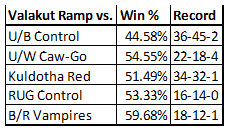
As expected, Valakut experienced a surge in popularity and success, placing five players in the Top 16 in addition to winning a fair share of its
matches. The big question for the weekend was “Green Sun’s Zenith or no?” and the answer is becoming clear. Julian Booher played the full amount in his list, while Brandon Nelson and Garett Young went with a pair to give themselves a few options. Robert Causey eschewed the card entirely, but time will probably
show us that some amount of Green Sun’s Zenith is correct.
The more successful Standard builds from PT Paris tended to run playsets of Green Sun’s Zenith and some amount of Lotus Cobras. The Zenith is growing
in popularity and should probably be considered the industry standard . . . unless the dominance of Jace-based control in Paris convinces some Valakut
players to pick up their (not-so) trusty Summoning Traps once again. With the knowledge that a significant proportion of Open participants play the
latest lists, it’s probably safe to assume that your Valakut opponent is playing Green Sun’s Zenith and not Summoning Trap—but that’s just what the
tricky ones will want you to think!
Valakut’s results were all pretty close matchups, with its weakness to U/B’s hard counters and Memoricides certainly enhanced by the loss of Summoning
Trap. That matchup has become worse, and players will need to acknowledge the difference. Being able to play Slagstorm against Jace and aggro while
boarding Thrun, the Last Troll will help, but I think Summoning Trap is an important part of the equation in that matchup. CawBlade’s Sword package is
likely to cause some problems as well, and U/W Control builds have access to all the tools one would want for defeating Valakut.
U/B Control — 13.60% of the Field — Won 55.42% of Matches
Best finishes: Christopher Hurley — 5th place, Indianapolis Open
; Adam Yurchick — 14th place, PT Paris

As discussed in my last breakdown, the San
Jose and Kansas City performances for the U/B archetype were mediocre at best. Still, many players were excited about the prospect of adding Mirrodin Besieged to the mix. Go for the Throat and Black Sun’s Zenith were welcome upgrades to the removal suite, giving players realistic outs
to Grave Titan in the mirror and a powerful sweeper against Plated Geopedes and Squadron Hawks alike. I half-hoped that Phyrexian Rager would get a
little play as a Sea Gate Oracle 2: Electric Boogaloo, but no such luck.
Watching the weekend unfold, a big problem for U/B appeared to be Kuldotha Red. While the matchup results above reflect a coin-flip, many players were
ill-prepared for the hyper-aggressive red decks—most of those wins came courtesy of the players packing Ratchet Bombs and/or Vampire Nighthawks,
earning them a sizable advantage. I watched plenty of players with lists tuned to beat Valakut and U/W fall to a mob of loud, tiny Goblins round after
round. Adaptation is the key to survival, and most U/B lists looked like the same old stuff.
A tiny Tezzeret showing means I have no data for the archetype, but a few players tried it out in Indianapolis to no success. Patrick Chapin took his Grixis build of Tezzeret to the Top 8 of PT Paris, splashing red
largely for free thanks to Prophetic Prism, Mox Opal, and Sphere of the Suns. I tried this deck out myself and was impressed with the amount of play to
it. It’s a fun deck that provokes a lot of thinking—just my style.
I like U/B Control in this format. While its Caw-Go matchup will be getting much worse thanks to Sword of Feast and Famine’s adoption by players, the
deck has a lot of weapons available to it. Finding one to beat Sword, however, is a tough nut to crack! Memoricide in particular is a feather in U/B’s
cap, as it’s very strong against Primeval Titan and Tezzeret—two cards I’m expecting to increase in popularity. I think a midrange guy like Vampire
Nighthawk is probably worth playing for your aggressive matchups. You can adapt the removal suite against the field you’re expecting, so the trick is
to expect the right field.
U/W Control — 12.50% of the Field — Won 50.85% of Matches
Vanilla U/W Control — 3.86% of the Field — Won 45.70% of Matches
Caw-Go — 8.09% of the Field — Won 53.47% of Matches
Best finishes: Michael Bernat — 8th place, Indianapolis Open;
Ben Stark — 1st place, PT Paris (CawBlade)
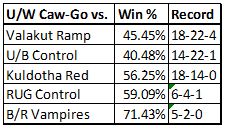
It took three Opens and a Pro Tour, but Squadron Hawk flavors of U/W Control are beginning to fully supplant the conventional strategies—no one made
the Top 16 of our Open or six wins at the PT without Squadron Hawk in their deck. Caw-Go was already putting up better results, even in the hands of
persons not named Brian Kibler, and the introduction of Stoneforge Mystic has made the deck even better than it was before. Ryan Allsup’s 9th place list from the San Jose Open was the first I’d seen to
try out the equipment package, but a large American contingent played it for Paris and posted a Top 8 and a win in the hands of Tom Martell and Ben
Stark.
The deck only had a reasonable weekend in Indianapolis, but the innovation of the equipment package, and especially Sword of Feast and Famine, will
have it posting big finishes soon enough. With such a high-profile victory, you should expect to be fighting Stoneforge Mystic and Squadron Hawk the
next time you spot a Seachrome Coast.
Kuldotha Red — 10.66% of the Field — Won 53.79% of Matches
Best finishes: Chris Andersen — 4th place, Indianapolis Open;
Petr Brozek — 25th place, PT Paris
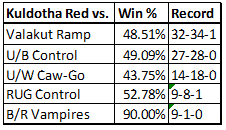
The breakout deck of Indianapolis broke a little too early for the Pro Tour hopefuls, but it had a fine weekend in both tournaments. Chris Andersen
took it to the Top 4 of the Indianapolis Open before being eliminated by an untimely series of mulligans over the live broadcast. Petr Brozek and
Timothee Simonot posted 8-2 records at the Pro Tour, with a few other players accruing six or more wins. The deck possesses blazing speed and volatile
combinations, but I’m not sure that I would recommend it to players now that it’s a known quantity. When people didn’t know you could kill them on turn
3 or 4, it was a lot easier to do it—those victories won’t flow as freely now that everyone understands and respects the strategy.
There are actually two different schools of Kuldotha Red—do you play Goblins, with Goblin Chieftain to add some explosiveness, or do you just slim the
curve and play all the tiny guys and most dangerous spells? Gerry Thompson favored the latter in his pre-Indy blog post, but it’s hard to say which performed better—we won’t really know
until the metagame has settled down. As for its matchups, I think that Kuldotha Red is at its best against metagames rather than decks. It’ll best the
players that are unprepared for it, but right now those players are few and far between.
RUG Control — 4.41% of the Field — Won 51.02% of Matches
Best finish: Shahar Shenhar — 38th place, PT Paris
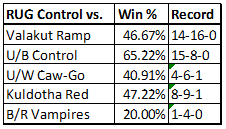
RUG had a great weekend in San Jose, but no surge in popularity followed. Mirrodin Besieged didn’t bring RUG much in the way of new tools beyond
Slagstorm, and even Slagstorm appears better-suited to Valakut and Chapin’s deck than it does to the RUG deck. For a tournament like Indianapolis,
denying players the opportunity to try out new cards and new strategies was probably a huge blow to the archetype’s popularity. That combined with an
increase in the popularity of Valakut to bode ill for anyone interested in livin’ the RUG life.
I don’t like our sample size for this deck, so I won’t spend much time analyzing the matchups. Valakut is probably a lot more awkward now that they are
playing more Lotus Cobras than you, so managing their mana advantage will be even more important. The Kuldotha Red matchup looks like a wildcard, but
just examining the lists and playing games in my head has me liking the Kuldotha side of it. Pyroclasm over Slagstorm would be helpful, but I don’t
know if players can afford that change in the main considering how handy being able to Slagstorm a Jace really is.
Shahar’s decklist from the Pro Tour is unique, featuring Precursor Golem as the hottest new broken thing to do following a turn 2 Lotus Cobra and
Inferno Titan on the top end. Golem is a nice call in a field excited to be playing with Go for the Throat, but the card’s weakness to Lightning Bolt,
Slagstorm, and Black Sun’s Zenith has me wondering if now is really the time. At a minimum, it’s food for thought.
Vampires — 5.51% of the Field — Won 48.24% of Matches
Mono-Black Vampires — 1.47% of the Field — Won 44.19% of Matches
B/R Vampires — 4.04% of the Field — Won 49.62% of Matches
Best finishes: Matthew Landstrom — 1st place, Indianapolis Open;
Christophe Gregoir — 58th place, PT Paris
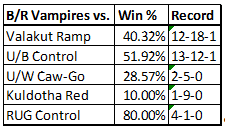
Vampires, Vampires, Vampires. This deck has had a swingy history, and Indianapolis wrote another volume in that series with a victory amidst dismal
performances elsewhere. I’m not sweating the win percentage, as it’s quite close to 50% and also has a pretty minor sample size, telling us little. The
real issue is that the deck just got bashed if your name wasn’t Matthew Landstrom! Only two other B/R players broke 18 points, and both finished well
outside of the Top 32. The versions without red fared worse, with a single player breaking 18 points and still failing to Top 32. Even worse, no
players at the Pro Tour garnered six wins.
Matthew Landstrom is clearly a Vampire virtuoso, making up for his lack of time to test by playing the deck he knew best. He played B/R Vampires for
Top 16 finishes at both the
Richmond Invitational
and the Kansas City Open
and earned the win in Indianapolis. He lost
only a handful of games over thirteen rounds, and none in the Top 8, and now he finds himself in contention for Player of the Year early. Practice makes perfect—Vampire decks, whether they
splash red or not, tend to offer a surprising amount of play thanks to the interactions between Viscera Seer and Kalastria Highborn.
I don’t see a particularly good reason to endorse this strategy at the moment, but that’s more because I dislike the deck’s place in the metagame than
because of its results. Granted, the stats don’t have anything good to say either, but the sample size is perilously small and should not be taken very
seriously for most archetypes. If you examine the results from San Jose and Kansas City, you’ll see that the deck performed poorly against Valakut,
U/W, and U/B across those events as well, so keep that in mind.
Finally, let’s talk Boros.
Boros — 3.13% of the Field — Won 52.44% of Matches
Best finish: Ben Robinson — 3rd place, Indianapolis Open; Paul
Rietzl — 2nd place, PT Paris
Boros had a very minor showing in Indianapolis, but Steppe Lynx still bared its fangs in the US and Paris over the past two weekends. With pretty near
misses on victory in both tournaments, Boros appears to be one of the top aggressive strategies in the format. It boasts a much more versatile game
than Kuldotha Red and is currently considered an actively bad matchup for the PT-winning CawBlade archetype. All of that adds up to a deck that is
probably going to grow in popularity, so be prepared.
Ben and Paul’s starting sixty are very similar, while Vincent Lemoine’s 3rd place list from Paris is a bit of a departure. I really like
the combination of Bonehoard and Stoneforge Mystic, and Mirran Crusader is incredibly dangerous alongside an Adventuring Gear. I suppose it’s fair to
say that he’s pretty dangerous around any equipment, really—this deck packs some exciting interactions that allow it to blaze out of the gates or play
a measured game where you power out threat after threat. The deck plays pretty well against Ratchet Bomb, which is earning more and more sideboard
slots following the emergence of Kuldotha Red. Of the decks outside our top-tier cut, Boros belongs in your gauntlet more than any other.
Well, boys and girls, that’s your Standard metagame. Following PT Paris, you should expect to see surges in the popularity of Boros and Tezzeret, and I
expect our Washington D.C. Open
to feature a mix of the Indianapolis and Paris metagames. I’m crossing my fingers to see someone break open Shape Anew or Infect, but I have a feeling
that we may be waiting for Mirrodin Pure (or New Phyrexia) before those archetypes hit the big-time. I’d love nothing more than to be
proven wrong, though!
The weekend of February 26-27 will set the tone of Standard for weeks to come, and it also kicks off our first of six Open weekends in a row. After the
D.C. Open, we’re heading to Edison, Memphis, Dallas, Los Angeles, and Atlanta, at which point I’ll slip into a coma. Show up for the first stop in
Washington, while I’m still alive! If you can’t, then Joey Pasco and Joe “bigheadjoe” Panuska will be bringing the event to you on SCGLive, starting at
noon on Saturday and at 8 am on Sunday.
In an effort to draw more significance and data from our Legacy results, I’ve decided to collect Legacy Opens together for articles. The goal will be one Legacy TMI per month, at a minimum. The problem is that our Legacy fields are much smaller, and the archetypes represented are very diverse. That makes population data useless and matchup data completely unreliable when examined after a single Open. Fortunately, Legacy doesn’t change much week-to-week, and the format’s age means that there are rarely any major shakeups—even decklists only change by a few cards for most players following a major tournament, if at all. I’ll combine D.C. and Edison with our Indianapolis results and deliver a Legacy article sometime in March.
–Glenn Jones
Coverage Content Manager
